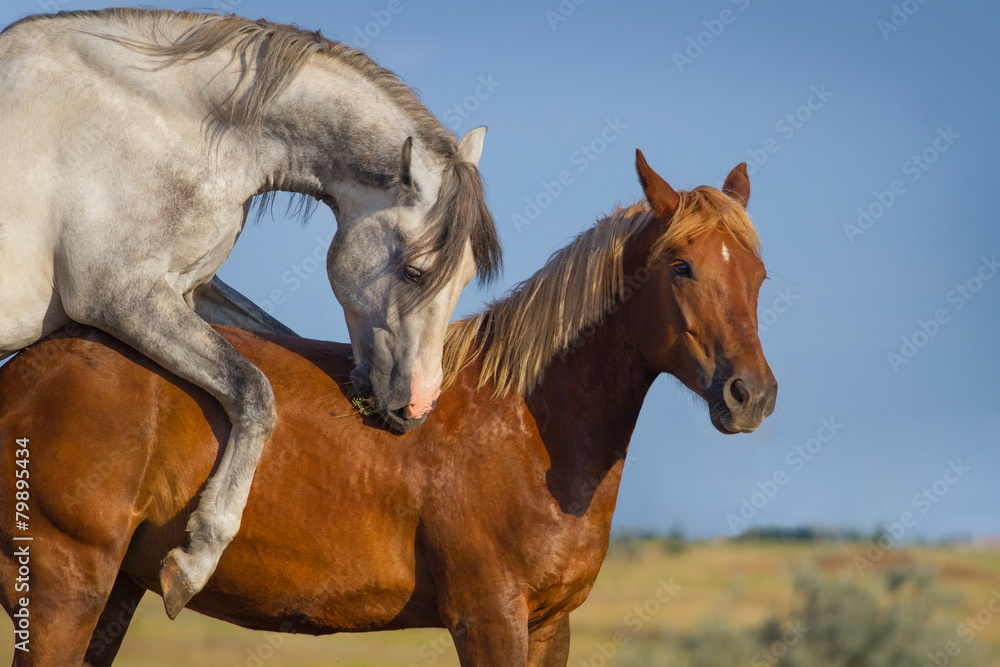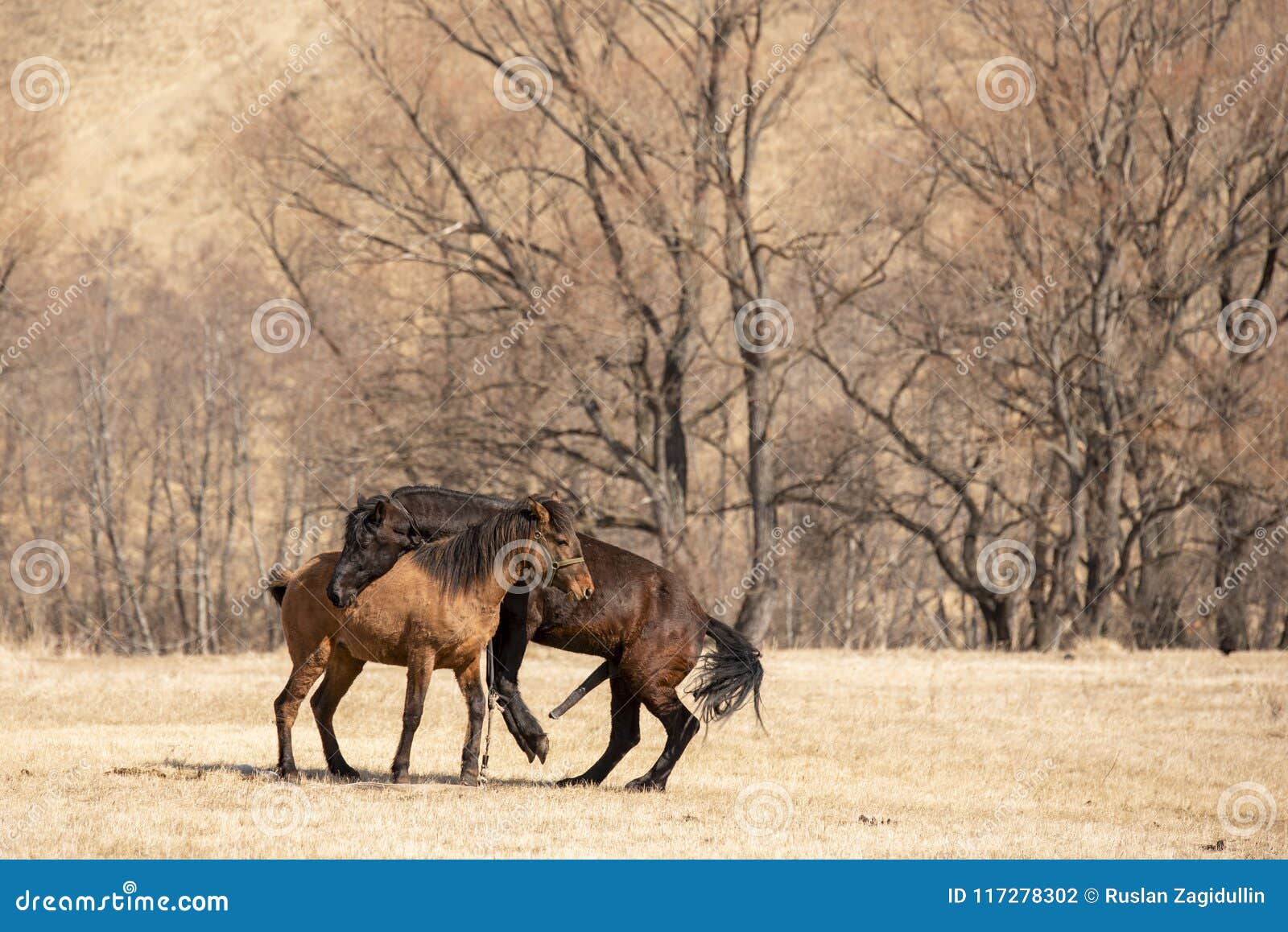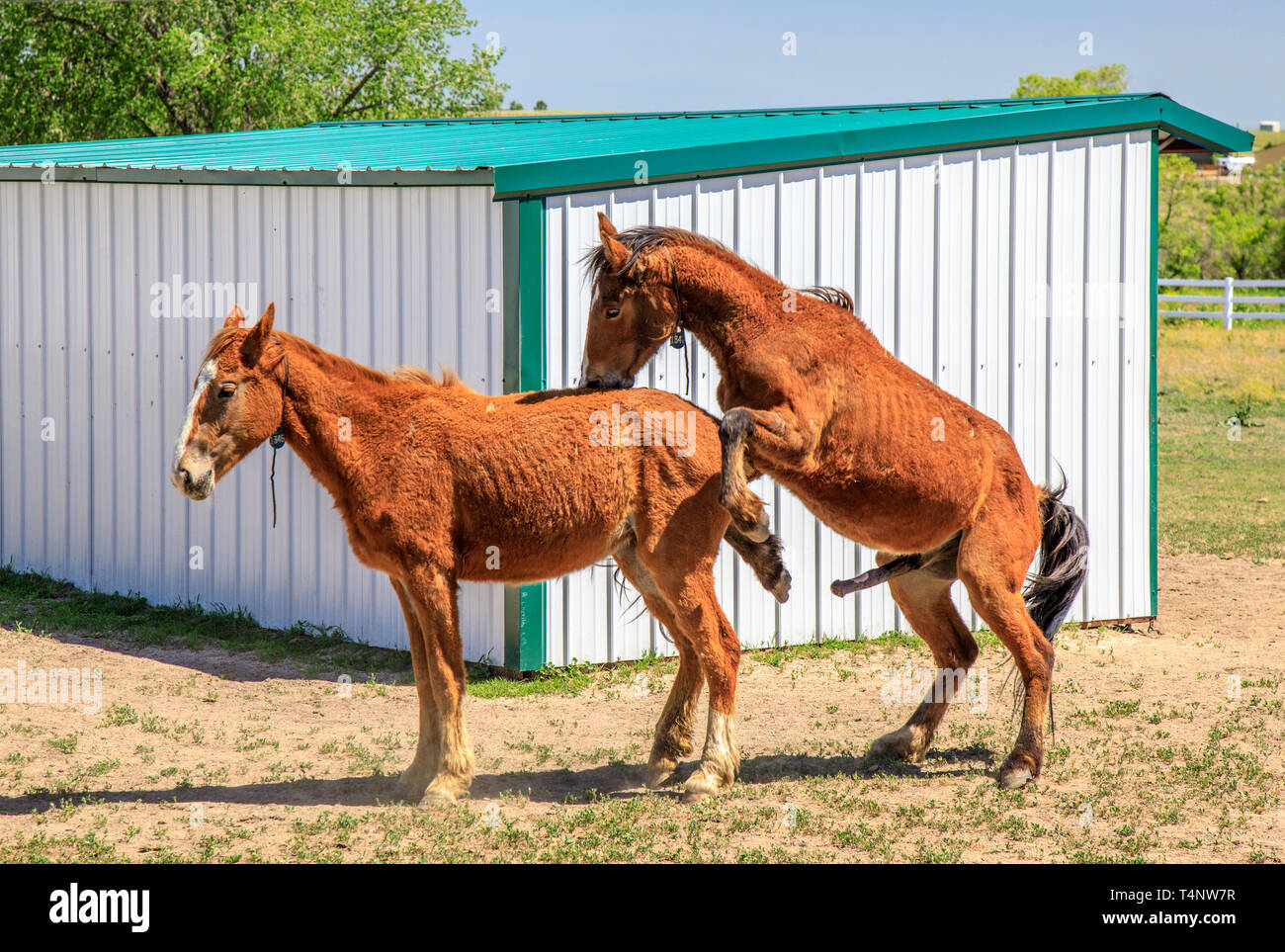Unveiling Horse Mating: From Courtship To Conception
Horse mating, also referred to as horse breeding, is a natural process essential for reproduction, fundamental to the continuation of equine lineages. It's a captivating aspect of equine biology and behavior, involving several intricate stages and behaviors that facilitate the transfer of sperm from the male to the female, ultimately leading to fertilisation and the creation of offspring. Understanding how do horses mate is not just for breeders; it's a fascinating journey into the very essence of life for these magnificent animals.
From the wild plains where natural instincts guide every interaction to the carefully managed environments of domestic breeding, the process of horse mating is a delicate balance of biology, behavior, and, often, human intervention. This article aims to explore the intricacies of equine reproduction, from the initial courtship rituals and signals to the actual mating act, in the wild or under human management. We will delve into the science of equine reproduction, gaining insights into stallion and mare behaviors, breeding seasons, and the crucial care tips that ensure the health and success of future generations of equine champions.
Table of Contents
- The Essence of Equine Reproduction: Why Horse Mating Matters
- Understanding the Equine Reproductive System
- The Intricate Dance of Courtship: Signals and Rituals
- The Act of Horse Mating: A Step-by-Step Guide
- Natural Pasture Mating vs. Controlled Breeding Methods
- Artificial Insemination: A Modern Approach to Horse Breeding
- Factors Influencing Successful Horse Mating and Conception
- Caring for the Mare Post-Mating: Towards a Healthy Foal
The Essence of Equine Reproduction: Why Horse Mating Matters
Horse mating, like mating in many other animals, is a natural process essential for reproduction. It's not merely a biological act but a cornerstone of equine survival and evolution. For horse breeders, owners, and enthusiasts alike, understanding the process and the intricacies involved in reproduction is paramount. It allows for responsible breeding practices, the preservation of desirable traits, and the overall health and welfare of the herd. The success of horse breeding directly impacts the future of various horse breeds, from workhorses and racehorses to beloved companions. It involves a detailed understanding of the behaviors and communication of the horses involved, as well as the physical act of copulation. This delicate process requires careful management and understanding, especially when humans are involved in facilitating it.
- How To Ask For A Spanking
- Jadeteen And Baby Alien Leak
- Taliya Gustavo Leaked
- What Is A Cubit
- Does Aoc Have A Life Partner
Understanding the Equine Reproductive System
Before delving into the behaviors of horse mating, it's crucial to grasp the fundamental biology behind it. Like most mammals, horses reproduce sexually, meaning it requires the genetic contribution from both a male (stallion) and a female (mare). The reproductive systems of both sexes are finely tuned, responding to hormonal cues and environmental factors to facilitate successful breeding. Learning about the reproductive anatomy of both the stallion and the mare provides a solid foundation for comprehending the entire breeding process. Hormones play a pivotal role, orchestrating the mare's receptivity and the stallion's readiness, making them critical elements in the success of horse mating.
The Mare's Oestrous Cycle: The Key to Receptivity
The female horse, or mare, goes through an oestrous cycle, often referred to as being "in heat." This cycle is similar to a menstrual cycle in humans, where she becomes receptive to mating. The oestrous cycle typically lasts around 21-22 days, with the mare being receptive to the stallion for about five to seven days within this period. During this time, the mare's body is unusually receptive to the stallion’s advances, driven by hormonal changes, particularly an increase in estrogen. Recognizing the signs of a mare in heat—such as tail flagging, squatting, urinating frequently, and a willingness to accept the stallion—is critical for successful breeding. If mating occurs and conception does not happen, the mare will usually go back into heat between seven to fourteen days after the first mating, allowing for another opportunity.
The Stallion's Role: Readiness and Potency
The male horse, or stallion, plays an equally vital role. While stallions do not experience a cyclical "heat" like mares, their reproductive readiness is influenced by factors such as age, health, nutrition, and the presence of a receptive mare. A healthy stallion is capable of breeding year-round, though their libido and sperm quality can fluctuate with the seasons, often peaking in spring and summer. Potency, or the ability to produce viable sperm, is paramount. Breeders often monitor a stallion's sperm count and motility to ensure his fertility. The stallion's behavior, driven by testosterone, becomes highly focused and intentional when a receptive mare is detected, signaling his readiness to engage in horse mating.
The Intricate Dance of Courtship: Signals and Rituals
The journey of horse mating begins long before the physical act, with a fascinating and often elaborate courtship ritual. This phase is crucial for establishing connection, assessing compatibility, and ensuring the mare's receptivity. Both stallions and mares exhibit specific behavioral signals that communicate their intentions and readiness. This dance of courtship is a testament to the complex social structures and communication methods within equine species, whether in the wild or under human management. Gaining insight into the mating behaviors of horses during this phase is essential for anyone involved in their care or breeding.
Wild Courtship: Nature's Unscripted Ballet
In the wild, horse mating is a truly unscripted ballet, driven purely by instinct and natural selection. Stallions in wild herds constantly monitor mares for signs of oestrus. When a receptive mare is detected, the stallion’s behaviors become more focused and intentional. He may gently nuzzle and nip at the mare’s neck and flanks, emitting rhythmic snorting or soft nickering sounds. The mare, if receptive, will often respond by raising her tail, urinating, and standing still, indicating her willingness to accept the stallion's advances. This intricate dance can last for hours or even days, with the stallion persistently, yet often gently, pursuing the mare until she is fully ready. It’s important to know that horse mating in the wild prioritizes the mare's natural cycle and willingness, allowing for a more organic process of selection.
Domestic Courtship: Facilitating the Connection
Under human management, courtship rituals for horse mating are often facilitated and sometimes abbreviated, though the underlying behaviors remain. Breeders aim to identify a mare in heat accurately to optimize breeding success. Once a mare is identified as receptive, she may be "teased" with a stallion. This involves bringing a stallion into proximity with the mare, often with a fence between them for safety. The stallion's reactions (snorting, vocalizing, erection) and the mare's responses (tail flagging, squatting, leaning into the fence) confirm her readiness. This controlled environment allows breeders to observe and manage the connection, ensuring that both animals are willing participants before the actual physical act of horse mating takes place. This careful observation is key to successful breeding programs.
The Act of Horse Mating: A Step-by-Step Guide
Once courtship has established the mare's receptivity and the stallion's readiness, the physical act of horse mating, or copulation, commences. This is the culmination of the courtship ritual and the direct means by which sperm is transferred to facilitate fertilization. While it may appear straightforward, it involves precise movements and coordination between the two large animals. How do horses mate physically? It's a process that demands the mare's cooperation and the stallion's careful approach, especially given the size and power of these animals.
The process typically unfolds in several key stages:
- Mounting: The stallion approaches the mare from behind. If she is receptive, she will stand still, often with her hindquarters slightly elevated and tail to the side. The stallion then mounts the mare, placing his front legs over her back and his chest against her hindquarters.
- Penetration: With the mare's vulva relaxed and open, the stallion achieves penile erection and attempts penetration. This requires careful alignment and the mare's continued cooperation.
- Thrusting: Once penetration is achieved, the stallion performs a series of rhythmic thrusts. These movements are designed to facilitate the ejaculation of semen into the mare's reproductive tract.
- Ejaculation: Ejaculation is typically marked by a characteristic "flagging" of the stallion's tail, a rapid up-and-down movement. This signals the successful release of semen. The entire copulation act is usually quite brief, often lasting less than a minute.
- Dismounting: After ejaculation, the stallion dismounts from the mare. Both horses may show signs of relaxation or satisfaction. The mare may stand quietly, and the stallion might nuzzle her or move away.
The success of this physical act is paramount for fertilization, leading to the conception of a foal. The timing of this act, relative to the mare's ovulation, is critical for maximizing the chances of pregnancy.
Natural Pasture Mating vs. Controlled Breeding Methods
When it comes to horse mating, breeders have two primary approaches: natural pasture mating or controlled breeding methods. Each has its advantages and disadvantages, and the choice often depends on the specific goals of the breeding program, the temperament of the horses, and the resources available. Exploring these methods provides insight into the diverse ways equine reproduction is managed.
The Advantages and Challenges of Pasture Mating
Horse mating in the wild and natural pasture mating is characterized by three distinct phases: courtship, copulation, and post-copulation. In a pasture setting, a stallion is turned out with a group of mares. This method closely mimics natural horse mating in the wild, allowing the horses to determine their own timing and interactions. The advantages include reduced labor for handlers, less stress on the horses, and often a higher conception rate due to multiple breedings over the mare's receptive period. The stallion can detect subtle signs of heat that humans might miss, ensuring optimal timing. However, there are significant challenges: increased risk of injury to both stallion and mares, difficulty in accurately tracking breeding dates and parentage (unless DNA testing is done), and the potential for disease transmission. The majority of horse couples will stay together for only a few days during the mare's heat, but the stallion remains with the herd, ready for subsequent cycles.
Controlled Breeding: Precision and Management
Controlled breeding methods involve human intervention to manage the horse mating process. This can include "hand breeding" (where the mare and stallion are brought together specifically for breeding under supervision) or artificial insemination. The primary advantage of controlled breeding is precision. Breeders can accurately record breeding dates, manage the number of breedings, and minimize the risk of injury. It allows for the selection of specific stallions for specific mares, optimizing genetic outcomes. It also helps prevent the spread of venereal diseases through careful health checks. However, it requires more labor, expertise, and can be more stressful for the horses involved, particularly if they are not accustomed to handling. Despite these challenges, controlled breeding is widely adopted, especially for valuable horses, as it offers a higher degree of management and safety.
Artificial Insemination: A Modern Approach to Horse Breeding
Because of the challenges and risks associated with natural horse mating, many of us have heard about artificial insemination (AI) in horses. AI is a modern and increasingly popular breeding method that involves collecting semen from a stallion and then manually inserting it into the mare's reproductive tract. This method offers numerous advantages, revolutionizing horse breeding. It allows for the breeding of mares and stallions located thousands of miles apart, reduces the risk of injury to both animals, and significantly minimizes the transmission of venereal diseases. Furthermore, it enables a single stallion's semen to be used for multiple mares, even after the stallion has passed away (through frozen semen). AI requires precise timing, often involving veterinary monitoring of the mare's oestrous cycle and ovulation. While it removes the physical act of horse mating between the animals, it relies heavily on human expertise and technology to achieve successful conception, contributing significantly to the creation of the next generation of equine champions.
Factors Influencing Successful Horse Mating and Conception
Successful horse mating and subsequent conception are not guaranteed outcomes; they are influenced by a myriad of factors. Understanding these elements is crucial for breeders aiming to maximize their chances of producing healthy foals. These factors range from biological readiness to environmental conditions and management practices.
- Timing of Breeding: The most critical factor is breeding the mare at the optimal time during her oestrous cycle, ideally close to ovulation. Veterinary guidance, using techniques like ultrasonography, helps pinpoint this window.
- Mare's Health and Condition: A mare's overall health, nutritional status, age, and reproductive history significantly impact her fertility. Mares that are underweight, overweight, or suffering from underlying health issues may struggle to conceive.
- Stallion's Fertility: The stallion's semen quality (sperm count, motility, morphology) and libido are paramount. Age, health, frequency of breeding, and nutrition can all affect a stallion's fertility.
- Breeding Season: Horses are "long-day breeders," meaning their reproductive activity is stimulated by increasing daylight hours. The natural mating season of animals, for horses, typically peaks in spring and summer (April to September in the Northern Hemisphere) when animals mate very strongly to reproduce. Breeding outside this natural season often requires artificial lighting programs.
- Stress and Environment: High stress levels, poor environmental conditions, inadequate nutrition, or sudden changes can negatively impact fertility in both mares and stallions. A calm, clean, and safe breeding environment is conducive to successful horse mating.
- Management Techniques: The expertise of the breeder and veterinarian in managing the breeding process, from heat detection to post-breeding care, plays a significant role in conception rates.
- Genetics: While not a direct factor in the act of mating, genetic compatibility and the absence of genetic reproductive issues can influence the likelihood of a viable pregnancy.
Each of these elements contributes to the delicate balance required for successful equine reproduction.
Caring for the Mare Post-Mating: Towards a Healthy Foal
The process of horse mating doesn't end with copulation; it's merely the beginning of a new chapter: pregnancy and the journey towards a healthy foal. Post-mating care for the mare is crucial to ensure successful conception, maintain the pregnancy, and prepare her for foaling. Breeders must transition from focusing on horse mating to nurturing the potential new life within the mare.
Key aspects of post-mating care include:
- Pregnancy Diagnosis: The first step is to confirm pregnancy. This is typically done by a veterinarian using ultrasound scans, often as early as 14-16 days post-ovulation. Early detection allows for timely management if the mare is not in foal.
- Monitoring for Return to Heat: If the mare is not pregnant, she will usually return to heat within 7 to 14 days after the first mating. Breeders must monitor for these signs to allow for re-breeding if desired.
- Nutritional Management: A pregnant mare's nutritional needs change. While early pregnancy doesn't require significant dietary alterations, as gestation progresses, her caloric and nutrient intake must increase to support fetal development and her own health.
- Veterinary Care: Regular veterinary check-ups throughout gestation are vital. This includes vaccinations, deworming, and monitoring for any health issues that could jeopardize the pregnancy.
- Exercise and Environment: Maintaining a moderate exercise routine and providing a safe, clean, and low-stress environment are essential. Mares should be protected from extreme weather and potential hazards.
- Preparation for Foaling: As the due date approaches, specific preparations are needed, such as moving the mare to a safe foaling stall, monitoring for signs of impending labor, and having emergency contact information for a veterinarian readily available.
Understanding these care tips is paramount for ensuring a successful pregnancy and the birth of a healthy foal, which is the ultimate goal of any horse mating endeavor. Is your horse in foal? Knowing the signs and providing appropriate care is key to a positive outcome.
Conclusion
The journey of horse mating is a profound testament to the natural world's intricate design, from the subtle nuances of courtship rituals to the precise biological mechanisms of conception. Whether observed in the wild or meticulously managed in domestic settings, horse mating is an essential part of horse breeding and a truly fascinating process. We have explored the basics of horse mating, including the vital role of hormones, the expressive behavioral signals, the physical aspects of copulation, and the myriad factors affecting mating success.
From the mare's cyclical receptivity to the stallion's powerful instinct, every element contributes to the creation of new life. We've seen how breeders navigate choices between natural pasture mating and controlled methods, including the transformative impact of artificial insemination in creating the next generation of equine champions. Ultimately, understanding these complexities is not just about reproduction; it's about fostering the health, welfare, and future of these magnificent animals. For more about horse reproduction, mare heat and gestation, and how horses give birth, continue to explore resources dedicated to equine care and breeding. Share your thoughts on this incredible process in the comments below, or share this article with fellow horse enthusiasts!
- Jason Scott Lee Bruce Lee Son
- What Is The Rarest Hair Color
- Mark Singer Gorilla Glue Passed Away
- Marta Sales Sales Wikipedia
- Julia Filippo Videos

Grey and red horse mating in the field Stock Photo | Adobe Stock

Two Horse Mating in the Field Stock Photo - Image of relationship

Stallion mating hi-res stock photography and images - Alamy